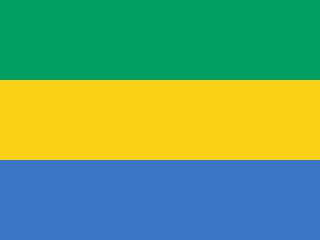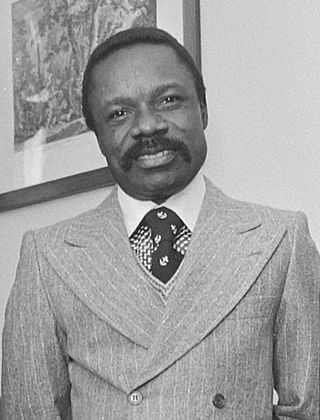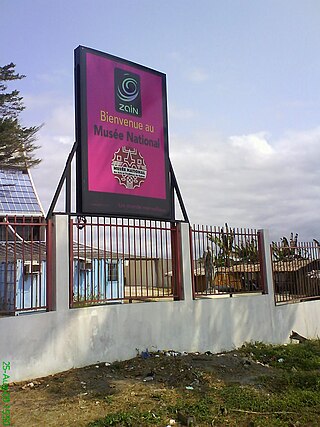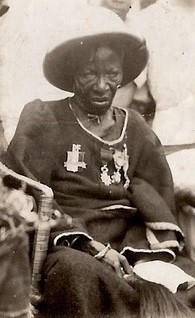
Gabon, officially the Gabonese Republic, is a country on the Atlantic coast of Central Africa, on the equator, bordered by Equatorial Guinea to the northwest, Cameroon to the north, the Republic of the Congo on the east and south, and the Gulf of Guinea to the west. It has an area of 270,000 square kilometres (100,000 sq mi) and a population of 2.3 million. There are coastal plains, mountains, and a savanna in the east. Libreville is the country's capital and the largest city.

The history of the Republic of the Congo has been marked by diverse civilisations: Indigenous, French and post-independence.

Omar Bongo Ondimba was a Gabonese politician who was the second president of Gabon for almost 42 years, from 1967 until his death in 2009. Bongo was promoted to key positions as a young official under Gabon's first President Léon M'ba in the 1960s, before being elected vice-president in his own right in 1966. In 1967, he succeeded M'ba to become the country's second president, upon the latter's death.

Likouala is a department of the Republic of the Congo in the northern part of the country. It borders the departments of Cuvette and Sangha, and internationally, the Democratic Republic of the Congo and the Central African Republic. The region has an area of 66,044 km² and an estimated population of almost 90,000. The chief town is Impfondo. Principal cities and towns include Epena and Dongou.
Articles related to Gabon include:

French is the official language in Gabon, however 32% of the people speak Fang as a mother tongue. French is the medium of instruction. Before World War II very few Gabonese learned French, nearly all of them working in either business or government administration. After the war, France worked for universal primary education in Gabon, and by the 1960-61 census, 47% of the Gabonese over the age of 14 spoke some French, while 13% were literate in the language. By the 1990s, the literacy rate had risen to about 60%.

The culture of the Democratic Republic of the Congo is extremely varied, reflecting the great diversity and different customs which exist in the country. Congolese culture combines the influence of tradition to the region, but also combines influences from abroad which arrived during the era of colonization and continue to have a strong influence, without destroying the individuality of many tribal customs.

Patience Marie Josephine Kama Dabany, also known by the names Marie Joséphine Kama and Josephine Bongo, is a Gabonese singer and musician. Dabany served as the First Lady of Gabon from 1967 to 1987. For 28 years, she was married to Omar Bongo Ondimba, who was President of Gabon from 1967 to 2009. After their divorce, she successfully pursued a career in music. She is the mother of the former President of Gabon, Ali Bongo Ondimba.
The Centre International des Civilisations Bantu (CICIBA) is a cultural organization based in Libreville, Gabon. Established at the initiative of Gabonese president Omar Bongo on January 8, 1983, it is dedicated to the study of the Bantu peoples.

The Anziku Kingdom, also called the Teke Kingdom, the Tyo Kingdom or Tio Kingdom, was a pre-colonial West Central African state of modern Republic of Congo, Gabon and Democratic Republic of Congo.
Kako is a Bantu language spoken mainly in Cameroon, with some speakers in the Central African Republic and the Republic of the Congo. The main population centres of Kako speakers are Batouri and Ndélélé in the East Region of Cameroon.
The Bongo people, also called Babongo or Bazimba, are an agricultural people of Gabon in equatorial Africa who are known as "forest people" due to their recent foraging economy.

Christianity is the predominant religion in Gabon, with significant minorities of the adherents of Islam and traditional faiths.

The Republic of the Congo, also known as Congo-Brazzaville, the Congo Republic or simply either Congo or the Congo, is a country located on the western coast of Central Africa to the west of the Congo River. It is bordered to the west by Gabon, to its northwest by Cameroon and its northeast by the Central African Republic, to the southeast by the Democratic Republic of the Congo, to its south by the Angolan exclave of Cabinda and to its southwest by the Atlantic Ocean.

Édith Lucie Bongo Ondimba was the First Lady of Gabon as the wife of President Omar Bongo from 1989 to 2009.

The official language of the Republic of Congo is French. Other languages are mainly Bantu languages, and the two national languages in the country are Kituba and Lingala, followed by Kongo languages, Téké languages, and more than forty other languages, including languages spoken by Pygmies, which are not Bantu languages.
Charles David Ganao was a Congolese politician who served as Prime Minister of the Republic of the Congo from 27 August 1996 to 8 September 1997.
The African nation of Gabon has had human inhabitants for perhaps 400,000 years. Bantu peoples settled here from the 11th century. The coastline first became known to Europeans through Portuguese and Dutch sailors. Colonised by the French in the 19th century, Gabon became independent in 1960.

Ngalifourou was a queen of the Mbé region in what is today the Republic of Congo (Congo-Brazzaville). As a ruler she was close to French colonial authorities and was the first ruler in her region to sign a treaty with them.
The Bongo family is a Gabonese family of Teke ethnicity. Two of its members were presidents of Gabon, ruling the country from 1967 until the 2023 Gabonese coup d'état.














